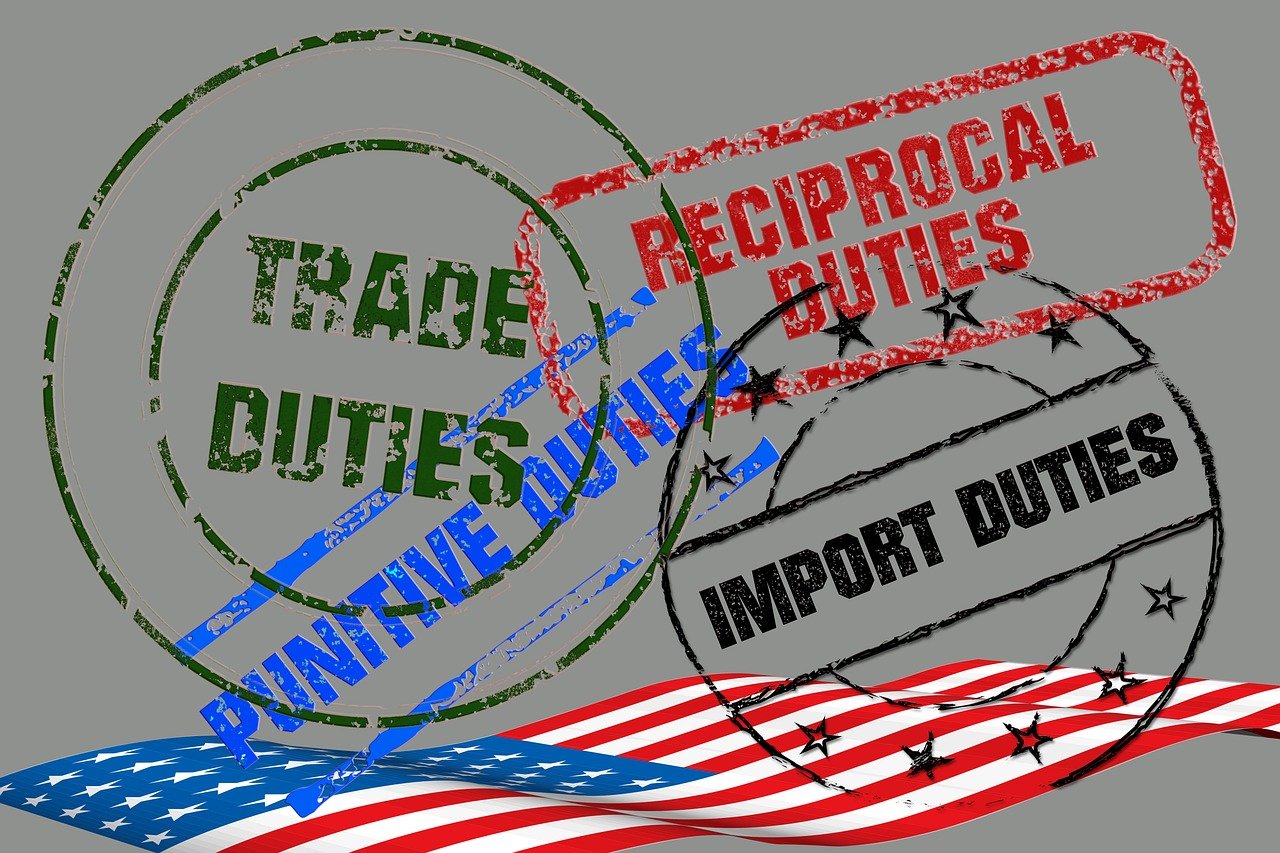
U.S. Hikes Tariffs to 145%, China Fights Back; EU, India Dodge Blow
Washington/Beijing: China pledged today to resist U.S. tariffs on its imports, now at 145%, after the White House confirmed the hike. This follows April 10, 2025, shipping fees and an April 9 travel advisory, as the European Union (EU), India sidestep costs while markets, Canada, and China face steep losses.
The U.S.-China trade war flared up today. The White House confirmed cumulative tariffs on Chinese imports reached 145%, prompting a fierce response from Beijing. When asked during a media briefing in Beijing today, Chinese Foreign Ministry spokesperson Lin Jian declared, “China does not want to fight these wars but is not scared of them,” adding, “If the U.S. is determined to fight a tariff and trade war, China’s response will continue to the end.” He insisted dialogue requires “equality, respect and mutual benefit” and warned against U.S. “maximum pressure,” saying, “Give the bully an inch, he will take a mile.” Lin Jian framed China’s stance as defending “international fairness and justice,” not just its own interests.
This builds on yesterday’s escalation. On Thursday, April 10, the United States President, Donald Trump, raised tariffs on Chinese goods to 125% and imposed docking fees on Chinese-built ships, targeting China’s shipbuilding dominance, over half the world’s tonnage, up from 5% in 1999, per a 2023 U.S. Trade Representative report. The U.S. produces fewer than 10 commercial ships yearly, against China’s 1,000. (The U.S. fewer than 10 figure refers to completed or ordered large commercial ships, while China’s 1,000+ reflects its massive annual output across various commercial types. The gap—China’s capacity being 232 times the U.S.’s by tonnage — 23.25 million vs. 100,000 tons—supports the scale difference.) Tammy Bruce, U.S. State Department spokesperson, said on April 10, “China’s decision to retaliate is emblematic of its decades of aggressive and unfair trade practices, and President Trump has taken appropriate action in response.” She noted, “China’s unfair trade practices are hurting not only the United States and our workers, but also market economies around the world.” Trade numbers fuel the fire—U.S. goods trade with China hit $582.4 billion in 2024, with exports at $143.5 billion, down 2.9%, and imports at $438.9 billion, up 2.8%, yielding a U.S. trade deficit of $295.4 billion, up 5.8%, per the U.S. Census Bureau.
The shipping order taxes Chinese port equipment, like cranes, and offers tax breaks to U.S. shipyards, down to 20 from 300 in the 1980s, per USTR data. The World Shipping Council estimates $30 billion in annual global shipping cost increases, potentially doubling U.S. export prices, echoing the 2020-2022 pandemic’s 300% freight rate surge, per UNCTAD’s 2022 Shipping Review. For U.S. consumers, that could mean $12 billion more in goods costs, per a 2024 Peterson Institute study. Lin Jian countered on April 10, saying, “The development of China’s shipbuilding industry is a result of companies’ tech innovation and active participation in market competition, which greatly contributes to global trade and the stable and secure operation of the global industrial and supply chains.” He blamed U.S. decline on “over-protection” and vowed, “China will continue to take strong measures to safeguard its own legitimate rights and interests,” backed by its 71% of 2024 global ship orders, per the China Association of the National Shipbuilding Industry.
China’s defiance goes beyond trade. On April 9, its Ministry of Culture and Tourism urged citizens to reconsider U.S. travel, citing trade disputes and safety concerns. Lin Jian linked it to U.S. actions, stating, “The situation is caused by the U.S.’s hegemonic and bullying acts of exerting maximum pressure,” noting these policies have “weakened the social and public foundations of China-U.S. relations and hindered exchanges and cooperation between the two countries in multiple fields.” Chinese U.S. visits dropped to about 2.1 million in 2024, down 25% from 2.83 million in 2019, per U.S. Department of Commerce estimates and the U.S. Travel Association. U.S. businesses, earning $14.2 billion from Chinese tourists in 2019, feel the pinch. The advisory highlighted U.S. crime: a 7% rise in violent crime, 5% in homicides, and 10% in anti-Asian hate crimes to 1,200 cases in 2024, per the U.S. State Department and FBI. It’s as much a diplomatic signal as a safety alert.
Markets buckled under the pressure. Global stocks lost $10 trillion from April 2-8, with SPY at $522.573 on April 11, down 3.8% from $544.83 on April 2, per real-time data. On April 10, Tesla, Nvidia, and Amazon fell 5-7%, Dollar Tree and Nike 8-12%, per Reuters, hit by tariff costs. Germany’s DAX dropped 4.2%, Canada’s TSX 2%, and China’s Hang Seng 1%. A 9.5% S&P 500 rally on April 9, after a tariff pause for some, faded by April 10. U.S. staples like Lamb Weston gained 2%, Indian IT like Infosys 3%, and gold rose 3% to $2,984, per Reuters, as safe havens and local sectors held up.
Not all felt the same sting. On April 9, the EU secured a 90-day tariff pause, cutting rates to 10%, as Trump cited non-retaliation by over 75 nations. Ursula von der Leyen, European Commission President, said, “We want to give negotiations a chance,” delaying $28 billion in U.S. countermeasures. India locked in a July 2025 trade deal framework, sparing pharmaceuticals and easing 26% tariffs on $14 billion in electronics, per India’s commerce ministry. Japan, South Korea, and Sri Lanka, with $3 billion in apparel exports, won pauses.
As of April 11, 2025, around 75 countries are actively negotiating with the United States to address President Donald Trump’s tariff regime, which currently imposes a universal 10% tariff on imports from most nations, following a 90-day pause on higher country-specific rates announced on April 9. Approximately 30–40 countries are adjusting their own tariffs, with some preparing retaliatory measures in case negotiations falter. China remains defiant, facing a 145% U.S. tariff and responding with 84% tariffs on U.S. goods, alongside export restrictions on rare earths. Canada has implemented targeted retaliatory tariffs on $20.6 billion of U.S. imports, including steel and aluminum, signaling defiance while still engaging in talks. Brazil and France have also indicated readiness to impose countermeasures if talks fail, with Brazil condemning U.S. tariffs as unfair to its steel exports.
The European Union, contrary to earlier indications, has paused its planned $22 billion retaliatory tariffs and is focusing on negotiations, with leaders like Ursula von der Leyen emphasising a preference for dialogue, though prepared to act if needed. Countries like Vietnam, Japan, and Israel are prioritizing negotiations to secure exemptions or relief, with Japan seeking to avoid auto tariffs and Israel discussing broader economic deals.
China’s 125% tariffs jumped to 145% today, and Canada’s 25% levies (10% on energy) held since March 4, with $87.4 billion in retaliation, per Canadian officials. China and Canada face steep losses because their retaliatory tariffs and refusal to negotiate locked in high U.S. tariffs, amplifying trade and market costs.
What’s really going on? It’s a high-stakes power struggle. The U.S. aims to revive its shipyards, but a 2024 Congressional Research Service report estimates $20 billion and a decade for 10% of China’s capacity, fueled by $150 billion in subsidies from 2000-2020, per a 2022 OECD report. China moves 40% of U.S. container imports, per the American Association of Port Authorities. The EU and India’s diplomacy bought time, but China’s 84% retaliatory tariffs and Canada’s deadlock risk $330 billion in U.S. exports. The IMF’s 2024 Global Trade Outlook warns of 0.5% annual GDP losses, hitting India’s $85.1 billion trade deficit with China in fiscal 2024—$65.89 billion imports, up 9.8%, and $8 billion exports, down 9.37% from April-October, per the Indian Ministry of Commerce. India’s $46 billion U.S. deficit and $1 trillion manufacturing goal by 2030, per NITI Aayog, hang in the balance.
The fallout’s global. The WTO counts 3,500 trade restrictions since 2019, 30% from U.S.-China clashes, straining Singapore’s 15% of global shipping, per UNCTAD. U.S. firms cut China investments by 40%, per the 2024 U.S.-China Business Council, while China ties 150 countries via Belt and Road, per Chinese official news agency Xinhua. The EU and India pivot, but China and Canada’s hard lines—like China’s 2023 rare-earth curbs raising tech prices 5%, per Reuters—could spark tougher measures. Indian IT gains, but import costs climb, a tightrope walk in a fracturing system.
This isn’t just trade—it’s a reshaping of economics and influence. China’s vow to fight “to the end” signals no retreat, while the U.S. digs in. For India and others, it’s a call to navigate higher prices, volatile markets, and shifting alliances in a world pulling apart.
– global bihari bureau





